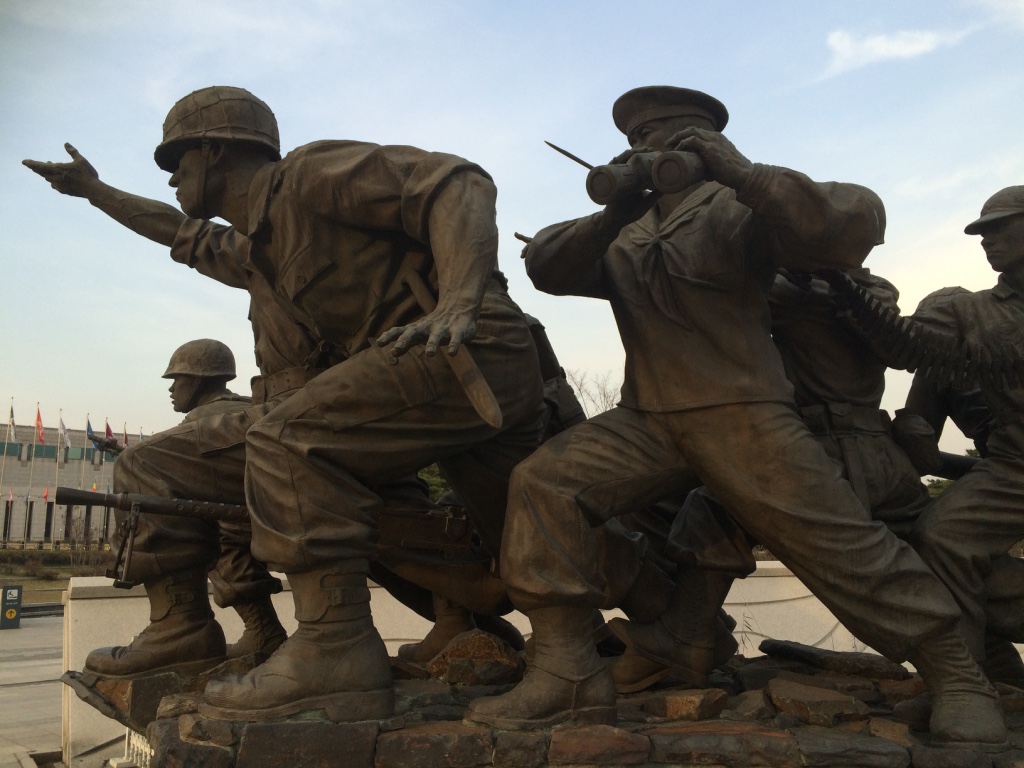April 1, 2016
Before coming to Seoul, we were guilty of not knowing much about Korean history or even much about the Korean War. That being said, it was important for us to learn more about its history in order for us to fully appreciate our time in Seoul. Our plan for today was to go to the DMZ and visit the Korean War Memorial Museum.
We booked a DMZ tour with Koridoor Tours, who operates with the USO (United Service Organization), which serves the American military and troops overseas. We arrived at “Camp Kim” at the USO at 7:30am to check in and wait until our bus left at 8am. Our tour group only had 9 people (2 people didn’t make the bus), mostly made up of Americans. Our tour guide was a small middle-aged Korean man named “SY Hong”.

The drive to the DMZ was about an hour from central Seoul. As we got further away from Seoul, the highway and scenery became very empty and sparse. The highway became lined with barbed wire and had watchtowers every few hundred metres or so.
Our first stop on the tour was the Imjingak Peace Park. This park is located just at the edge of the Civilian Control Zone, 6km away from the southern edge of the DMZ. The park is a place where many South Koreans go to remember relatives who are still in North Korea. The main sight here is the Freedom Bridge, which is where South Koreans came back from North Korea after the signing of the Armistice Agreement in 1953. This area is used every year for a lot of unification events.






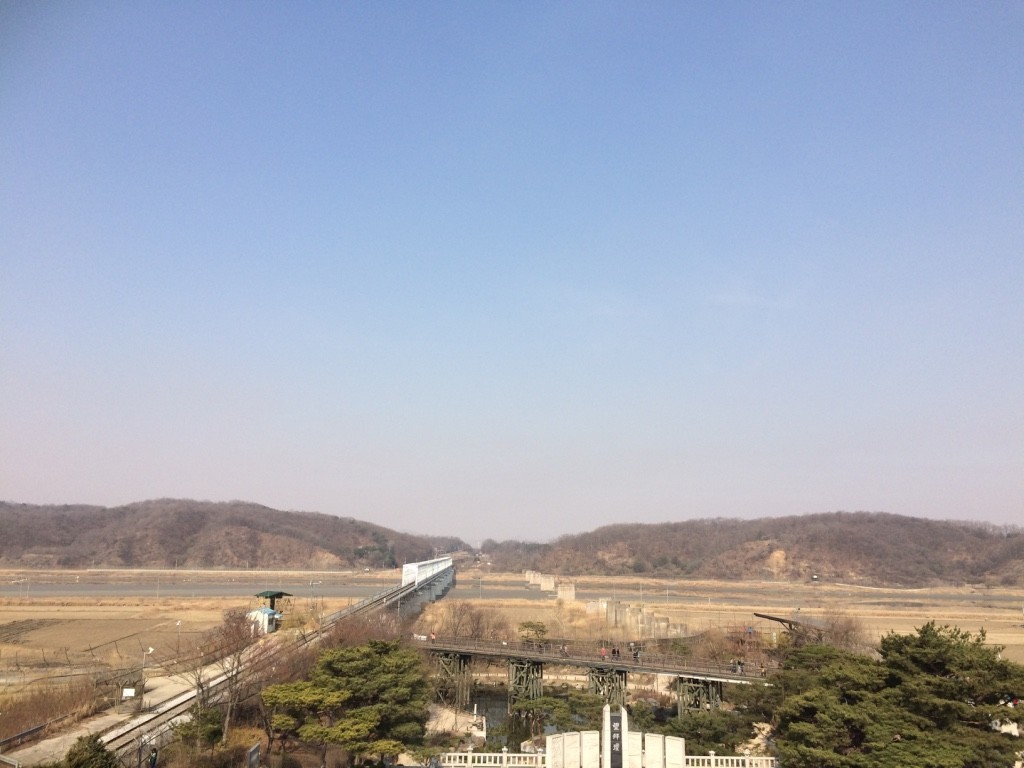
Our next stop was inside the Civilian Control Zone (behind a security check point) and extending into the DMZ. When signing up for this tour, they require around 4 days in order to register each person with a valid passport. The tour company then has all this information ready for the security checkpoint so they can verify everyone going into the CCZ. After each security check point, the bus can’t drive straight, but has to maneuver around large blockades to prevent cars and buses from speeding in the DMZ.

Our first stop within the CCZ was the “Third Tunnel of Infiltration” by North Korea. South Korea has discovered four tunnels so far that were designed to be used for surprise attacks on Seoul but were found before the could be used. The Third Tunnel is about 1,635 metres long, 2 metres wide, and runs about 73 metres below ground. It can allow up to 30,000 infantry to pass per hour. South Korea thinks there are more tunnels built by North Korea that they still have not yet found.
We were able to go down into the tunnel and reach the third concrete barricade that South Korea installed to block any access from the North. The walk down is pretty steep and dark. If you’re claustrophobic, I would recommend not going down into the tunnel as there are a lot of people from other tours down there as well. It took about 10 minutes to walk down to the tunnel and another 5-8 minutes to walk to the third wall barricade. You can see the second barricade wall through the third. This was the closest we got to North Korea, as we were within the DMZ and only 170m away from the Military Demarcation Line (i.e. ceasefire line), but underground. This was really cool, but unfortunately no pictures are allowed in the tunnel as you have to lock up all your belongings before going down.

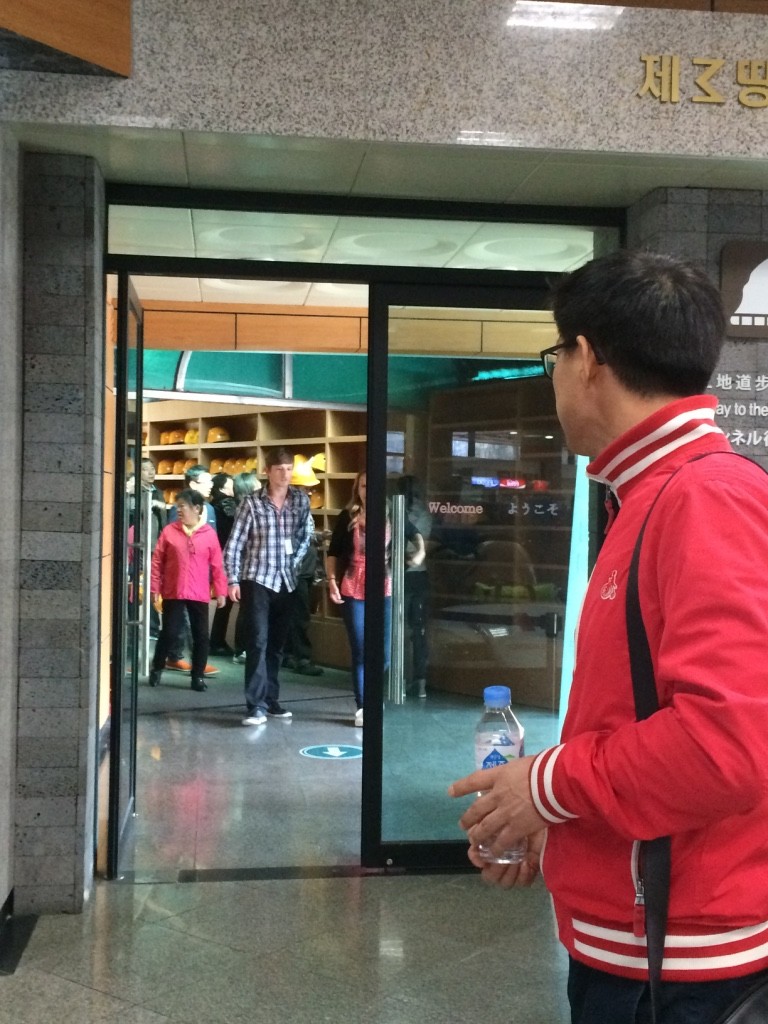

Our next stop was Dora Observatory, which is a viewpoint situated on top of Dorasan mountain overlooking North Korea. This viewpoint is the closest you can get in South Korea to North Korea (without being in a tunnel). There are binoculars (500 KRW = $0.56 CAD) set up at the observatory so you can see the closest city in North Korea, Kaesong or Gaesong depending on how it’s anglicized.
Kaesong Industrial Park was used by about 120 South Korean companies to manufacture goods with cheap labour. The companies paid the North Korean government their wages directly and employed 53,000 Kaesong citizens. But due to recent tensions between the two countries, the industrial park has since been closed as protest against the North about their recent aggressive actions – e.g. their satellite launch and claimed hydrogen bomb test in January 2016. The plants actually just closed in early February, which made going to the next two stops even more interesting.
Since it was a hazy day, we were only able to see outlines of the buildings in Kaesong City. We also saw the large North Korean flag flying in “Propaganda Village” on one side and the South Korean flag flying on the other. According to our tour guide, the North and South were having a flag pole height war (Tim: “Dick measuring contest”) for a while, but the North “won” with their 160m flag pole. We could also hear propaganda blasting from loud speakers coming from the North. (Tim: “Propaganda Village” is a bizarre fake town with buildings that only have painted on facades, used to try and attract South Korean defectors. Also built at a time when telescopes and binoculars sucked apparently).
Unfortunately, you aren’t allowed to take pictures from the ledge so everything that we saw I couldn’t photograph. You are only allowed to take pictures about 15 feet away from the ledge, which basically means you can’t photograph anything.
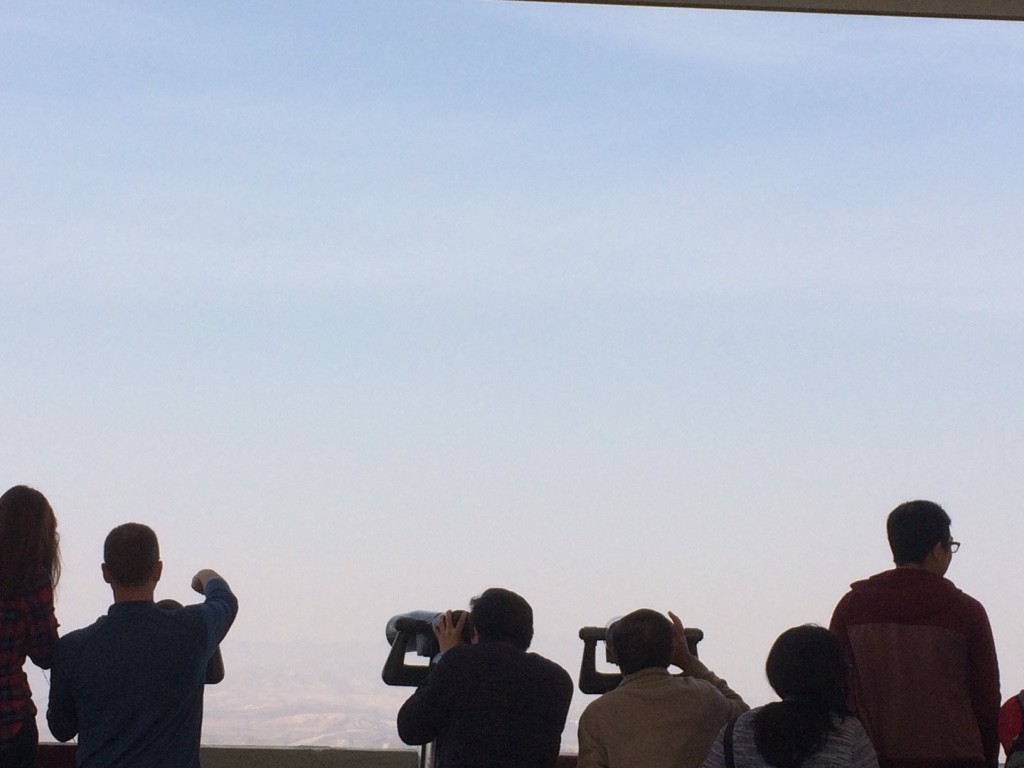


Since the closing of the industrial parks in Kaesong, there is no permitted travel across the border at this time. This made visiting the Dorasan Train Station and immigrations/customs centre very interesting since there was no activity at all. The train station and immigration centre were eerily empty.




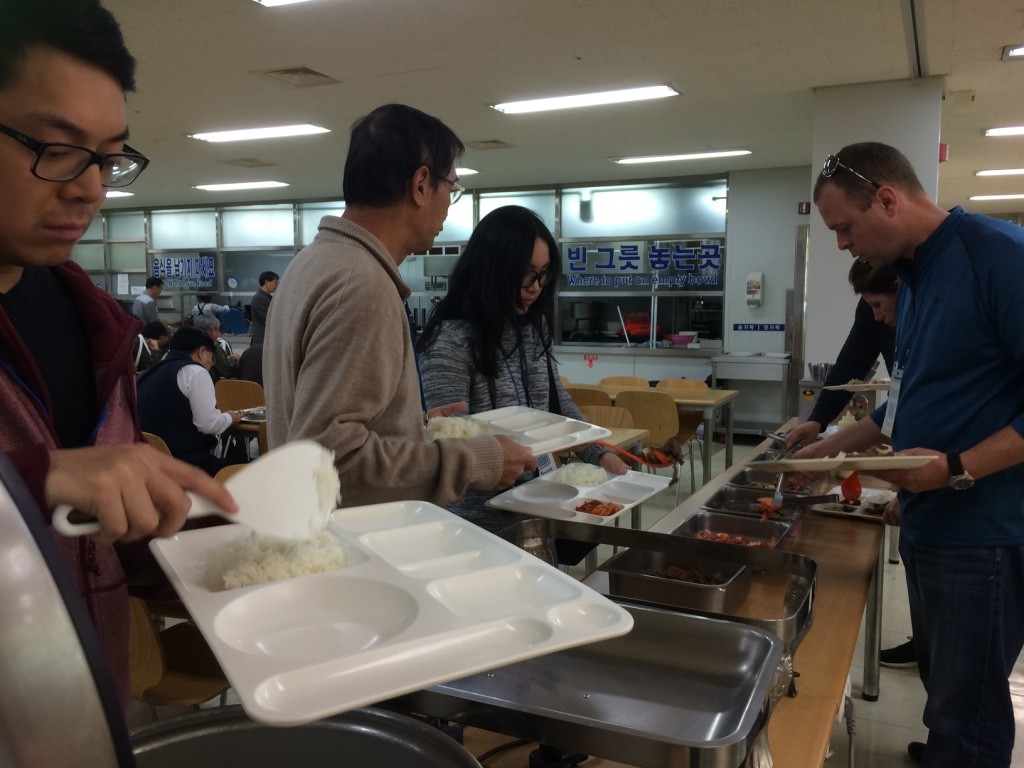


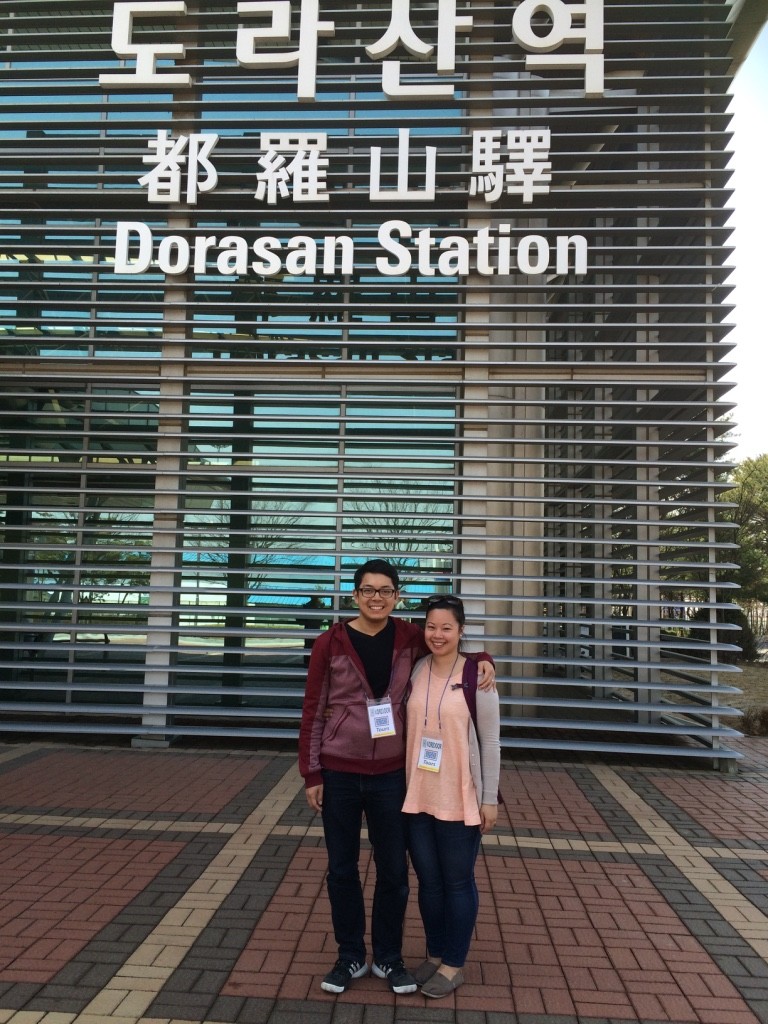




Our DMZ tour ended around 1pm and we got back on the bus and headed back to Seoul. I fell asleep on the whole bus ride back. We both really enjoyed the DMZ tour and learned a lot about the Korean War. Originally we wanted to do the DMZ/JSA tour, but the JSA tours were all fully booked. JSA is the “Joint Security Area” which is the only place in the DMZ where North and South military personnel are standing facing each other. Next time we come to Seoul, I would want to go to the JSA. We’ll book earlier next time!
When we got back to Seoul, we walked over to the Korean War Memorial Museum to spend the rest of the afternoon. The museum has free admission and is worth spending a few hours in (at least). Tim and I took our time to go through everything and we both learned a lot about the Korean War and it was a perfect place to go to after visiting the DMZ since we could tie together everything we learned. The threat from the North is still very evident as they have proven to not obey the Armistice Agreement since it was signed in 1953. There has been several aggressive acts from North Korea since then, as recent as 2010, when they bombed Yeonpyeong Island.
The wish for unification was very strong both at the DMZ and at the museum. We learned that North Korea was very close to being defeated (and Korea unified) with the help of American and other UN countries during the Korean War, but it was only when China joined to help North Korea that South Korea lost ground and they retreated back to the south (below the 38th parallel, which is basically the original border).
I’m always left humbled when going to war museums when you learn about how so many young men and women didn’t hesitate to fight for freedom and for their country (Tim: or more striking, for a country that isn’t even theirs). Without these fearless individuals the world would be a very different place.





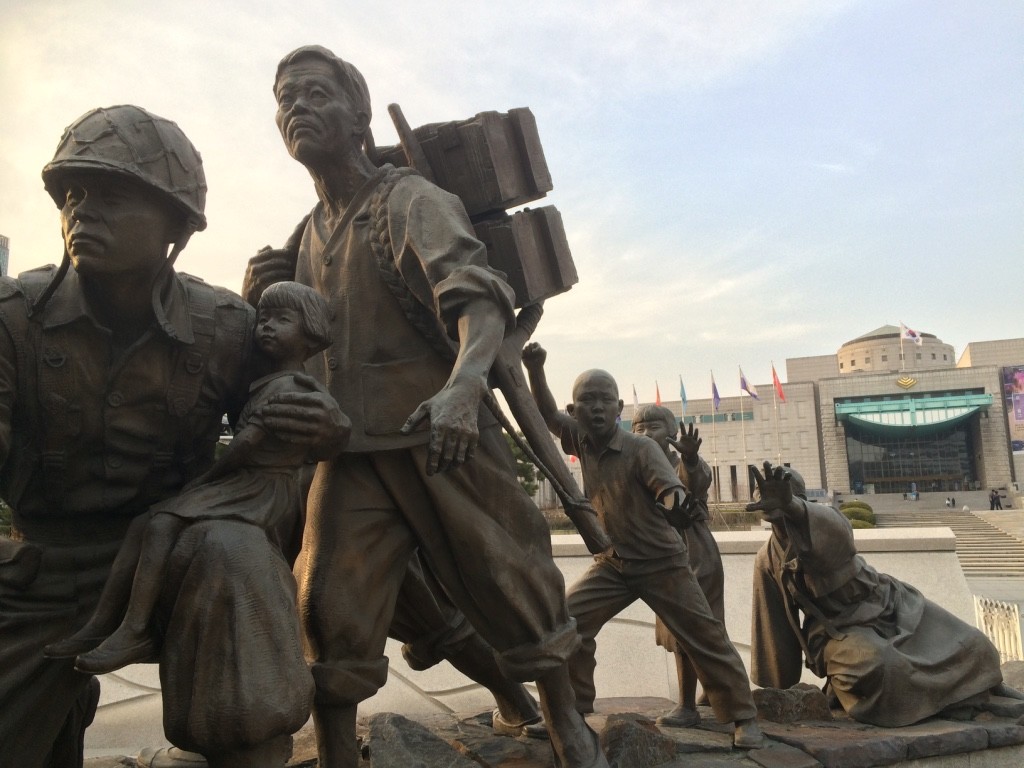
After about 3.5 hours at the museum, we made our way back to our hotel. We got off the train and walked through Namdaemun Market. The first night we got into Seoul we walked down this street but we learned that it closed at 9pm. Namdaemun Market is basically a cheaper version of Myeongdong with lots of socks and fake everything. We walked through a street with food stalls and the older Korean ladies were quite aggressive trying to get us to sit down – Tim was grabbed a couple of times.



We rested up for a bit and then decided to go for Korean fried chicken. The first night we walked around we noticed a bunch of chicken and beer restaurants (where all the businessmen were) so we decided to go back and try, “Chicken Mania”. We ordered an original fried chicken and it was juicy and delicious!

After a long day, we came back to the hotel room around 9pm and plan on taking it easy for the rest of the night.
Steps today: 21,000

